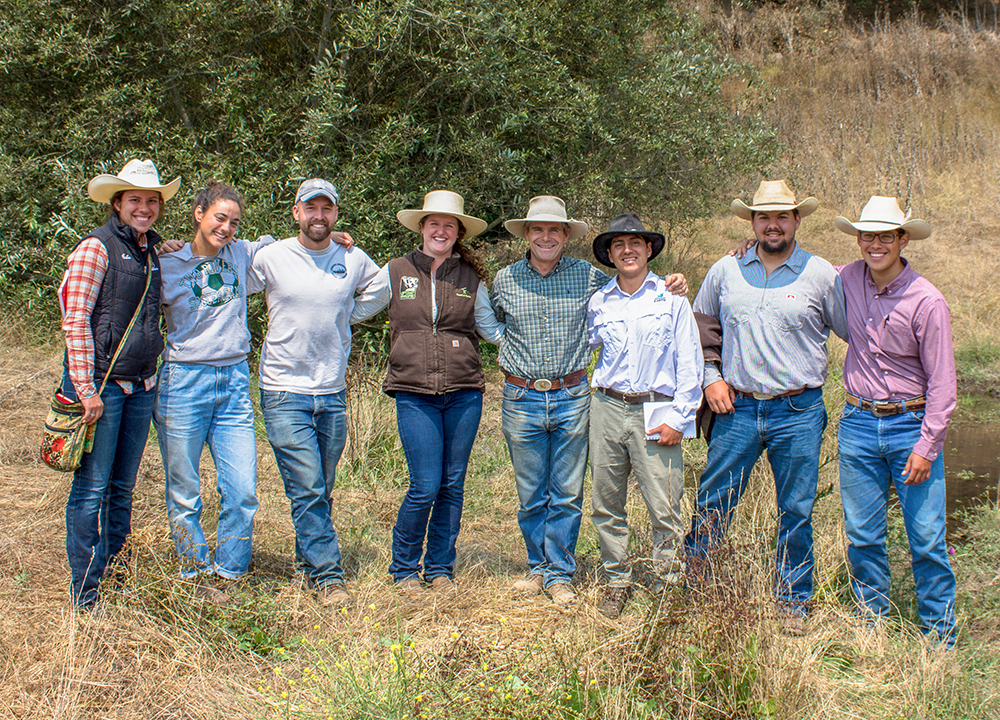Where are they now – Catie Mong. By: Kathy Webster and Catie Mong

Where are they now – Catie Mong
11/18/2024
By: Kathy Webster and Catie Mong
I enjoy staying in touch with our past interns and apprentices, so it was fun to catch up recently with Catie Mong, who was a summer intern in 2016 and now works at Point Blue Conservation Science, TomKat Ranch’s science partner.
Catie shared some insight into her time at TomKat Ranch.

Catie (floral pattern top and sweater) with the 2017 interns and apprentices.
How did you find out about TomKat Ranch?
Catie: I was at Stanford University and getting my master’s in Earth Systems with a focus on Land Systems and came across TomKat Ranch’s available summer internship.
How did you get involved in agriculture/ranching in the first place?
Catie: It’s a story that starts with cheetahs. In my sophomore year (of College), I did an internship with the Cheetah Conservation Fund (CCF) in Namibia. Initially, I did it because I was fascinated with big cats, however, the most impressionable part of the internship was CCF’s emphasis on the need to secure a future for local people in order to secure a future for cheetahs. They had a model predator-friendly farm and a highly successful livestock guardian dog breeding program where they gave the puppies to farmers for free in exchange for not shooting the cheetahs.
Later, I had the opportunity to do an overseas seminar on wetlands in the Brazilian Pantanal. It was a similar situation where rangelands were considered valuable for conservation while also having predator-rancher conflicts with jaguars. However, it seemed like local non-profits were not as inclusive when working with local ranchers. The following summer I interviewed ranchers about their perceptions of jaguars and conservation efforts. After that experience, I knew I wanted to continue working at the intersection of ranching and conservation, but I wanted to gain firsthand experience in ranching. That’s when I came across the internship posting for TomKat Ranch.

Catie helping to prepare a meal for an event at TomKat Ranch.
What was your favorite memory at TomKat Ranch?
Catie: I would have to say getting to move the cows on horseback. Most of the time we would do it on foot or by ATV, so the times we got to use horses were special. I loved the days when we would move cows and be above the fog layer. It was such a peaceful feeling.
A second memory, not necessarily my favorite, but will stick with me forever is the day we were invited to learn how to slaughter the turkeys we helped raise. I told myself that I had to be a vegetarian if I couldn’t handle it. It was a grounding experience where we started the day with a moment of gratitude. To embrace regenerative agriculture, we must accept that death is a part of what sustains life. I took that frozen turkey home to Texas in my checked bag for Thanksgiving dinner.
Who was the most influential person during your time at TomKat Ranch?
Catie: It’s so hard to pick just one person! I learned something from every single person I interacted with. However, if I have to pick just one, I would say Point Blue biologist Mel Preston as they changed the course of my life and career since I now work for Point Blue Conservation Science. Whenever I could, I would ask to join them on their vegetation surveys or bird banding.

Catie (on the left) with TKREF team members at Morris Grassfed.
Where are you and what are you doing now?
Catie: I am a biologist with Point Blue Conservation Science working in partnership with the USDA Natural Resources Conservation Service (NRCS) in Merced County. I work with farmers and ranchers to facilitate conservation planning and provide technical and financial assistance. The goal is to build soil health, and promote wildlife habitat and ecosystem services while maintaining economic function in the face of challenges like climate change and water shortage in the Central Valley. Additionally, I conduct soil, vegetation, and bird surveys as part of Point Blue’s Rangeland Monitoring Network, which TomKat Ranch is part of.
How did your TomKat Ranch experience shape where you are and what you are doing now?
Catie: When I arrived at TomKat Ranch, I knew I wanted to work at the intersection of ranching and conservation, but I thought that would be in the realm of predator-rancher conflict. However, TomKat Ranch is where I learned about regenerative agriculture and the power of grazing to increase soil carbon, improve wildlife habitat, and reduce wildfire risk. I became more interested in helping ranchers continue to be good stewards of the land rather than focusing on the ecology of one animal. If I had never taken this internship, who knows if I would have learned about Point Blue! I can tie a direct line to where I am now to TomKat Ranch, and I am grateful that we continue to be close partners.